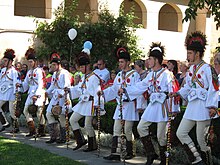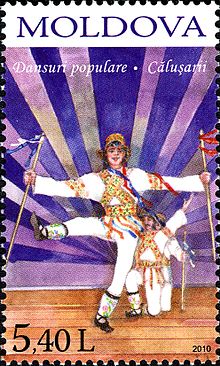Căluşari

The Călușari are originally members of a fraternal secret society in Romania who practice a ritual dance , the "Căluș" .
Origin and Etymology
The origins of the Căluşari are obscure, the first recorded mention is possibly in the musical notation of Ioan Căianu from the 17th century. According to Eliade and other scientists, the term Călușari comes from the Romanian word for "horse" cal (from Latin caballus ). On the one hand, they refer to the mythological importance of the horse in terms of fertility and war, as well as to the imitation of the horse in certain dances. The derivation from the Latin double form collusium , collusii , which means both “dance group” and “secret society”, is generally accepted .
description
According to the well-known Romanian religious scholar Mircea Eliade , they have the characteristic ability to create an illusion that makes them appear dancing in the air. The dance is intended to symbolize a galloping horse on the one hand and the dance of the fairies (zine) on the other . Indeed, the patron saint of this group is "the Queen of the Fairies" (Doamna Zinelor) , who is also known as Irodiada and Arada and is identified by Eliade with Diana . Because of their association with fairies, it was believed that Călușari could heal the fairies' human sacrifices. For the time between the three weeks after Easter and Pentecost , they visit regional churches to dance and heal. During their dances the Căluşari carry a club and sword as well as a wooden horse's head and a flag, by which they swear to treat each other in a brotherly manner, to respect the customs of the Căluşari and to remain abstinent for the next nine days.
revival
In the mid-19th century, some Romanian intellectuals, under the leadership of Iacob Mureșan, collected old folk dances. They renewed the Căluș by giving it structure and solid form. From this, in turn, new forms emerged, which quickly spread across the country, the actual purpose and ritual meaning have been completely lost.
literature
- Andrei Bucşan: Contributions à l'étude des danses des “Căluşari”. In: Revista de Etnografie și Folclor. Vol. 21, No. 1, 1976, ISSN 1220-5370 , pp. 3-20.
- Mircea Eliade : Some Observations on European Witchcraft. In: History of Religions. Vol. 14, No. 3, 1975, ISSN 0018-2710 , pp. 149-172, JSTOR 1061939 , (again in: Mircea Eliade: Occultism, Witchcraft and Cultural Fashions. Essays in Comparative Religions. Chicago University Press, Chicago IL et al 1976, ISBN 0-226-20391-3 , pp. 69-92).
- Mircea Eliade: Notes on the Călușari . In: The journal of the Ancient Near Eastern Society of Columbia University. Vol. 5, 1973, ISSN 0010-2016 , pp. 115-122, ( digitized version (PDF; 883.5 kB) ).
- Anca Giurchescu: A Comparative Analysis between the “Căluş” of the Danube Plain and “Căluşerul” of Transylvania (Romania). In: Studia Musicologica Academiae Scientiarum Hungaricae. Vol. 43, No. 1/2, 1992, pp. 31-44, doi : 10.2307 / 902359 .
- Gail Kligman: Căluş. Symbolic transformation in Romanian ritual. Chicago University Press, Chicago IL et al. 1981, ISBN 0-226-44221-7 .
Web links
- Southern Romanian Căluş (English)
